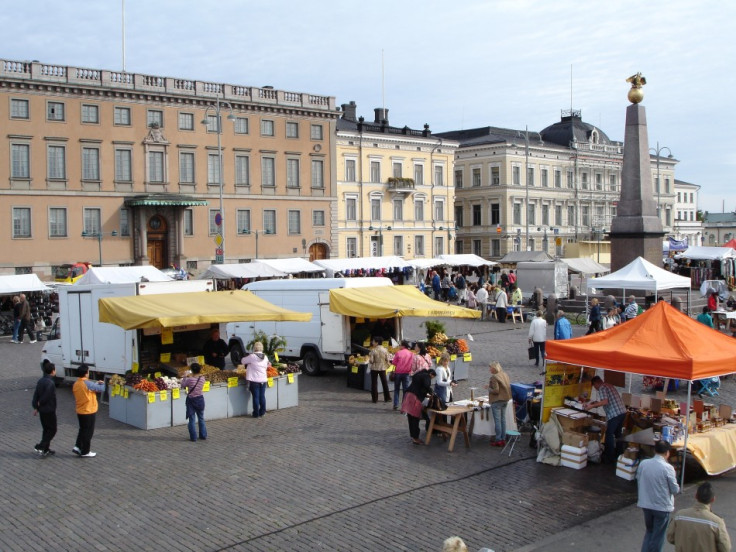Graduate Jobs: No El Dorado at the end of the unemployment line
With youth unemployment remaining at near record levels many university students graduating in the coming months will face a slew of challenges unique to their generation.
The latest unemployment figures from the Office for National Statistics (ONS) show that under-25s are hardest hit by Britain's depressed job market. The number of people aged between 16 and 24 who were out of work hit 963,000 in the three months to February. This pushed Britain's youth unemployment rate up by 0.1 per cent to 20.4 per cent.
The problem is compounded as those collecting degrees are also competing with recent graduates from 2008, 2009 and 2010 who still lack steady work. So what steps can this summer's university leavers take to ease their transition into a turbulent job market, IBTimes UK investigates.

Choosing the right career
After three years of being told to follow their dreams and passions at university; today's graduates will find that their early years in the job market, are "the most important for signaling" one's career potential to employers, according to Lisa Kahn, an economist at Yale University.
"All you've got is college first, so there's a lot of room for employers to form impressions. After a few years and a few jobs, those impressions solidify and it's harder to change them," she told the National Journal.
With jobs so scarce, many graduates are forced to take low-level, low-prospect jobs that can create an "impression of underachievement that may be hard to shed".
There is a danger that taking on too many low-status jobs in a short time frame after graduation can become cyclical. Don Peck, writing in the National Journal earlier this year, listed the challenges facing graduates in today's job market and warned them to get serious about a career sooner rather than later. "The window for getting onto a good track, arguably, is narrower than it used to be," he said.
The longer that graduates spend exploring different career paths in their 20s, the harder it becomes to change career five or ten years down the line, he said.
"Earnings tend to grow much more [quickly] early in one's career than later," noted Princeton University economist Henry Farber.
One prominent study shows that, adjusting for inflation, about two-thirds of all lifetime income growth occurs in the first 10 years of a career, when people can switch jobs easily, building up their earnings.
People who can't immediately step onto a desirable career curve due to a bad economy have a much harder time doing so later, when mortgages and marriages have made them less mobile, and when many employers will frown upon a disappointing C.V.
Even an eventual return to boom times won't change that, Farber explains. "If you happen to have the bad draw early on and the good draw later, it's going to be hard to fully recover."
David Brooks, writing in the New York Times, went even further arguing that it is indicative of this 'perversely structured' generation that pursuing one's dreams should be so greatly sought after.
"College grads are often sent out into the world amid rapturous talk of limitless possibilities," Brooks wrote. "But this talk is of no help to the central business of adulthood, finding serious things to tie yourself down to."
Brooks also cautioned against what he called the "misleading mantra" of "expressive individualism" that encourages graduates to "find their passion and then pursue their dreams."
But as Lane Wallace argued in a recent piece in The Atlantic, "passion...is often misunderstood or confused with other motivations."
Many people view dreams and passion exactly as David Brooks outlined, as liberally idealistic, irresponsible and selfish. In other words, the exact opposite of the individual's obligation to society, and far removed from the parameters by which we tend to judge security and success.
Fresh start
All this negative talk paints a wholly discouraging portrait of adult life, one that few students and recent graduates will be keen to enter into. But this dour scenario fails to take into account the true picture of life outside the confines of university.
The very fact that young graduates are mobile and relatively free of commitment means they are able to move to where the jobs are, to follow a passion -- their passion -- wherever the market takes them.
Even in this economy, a stable, low-level job in an ordinary company may not be as good a long-term bet as a stretch role at a start-up, or a yearlong contract with a well-regarded company. Early on, signals matter more than stability, says Peck.
While there is no El Dorado at the end of the unemployment line, choosing a city to live in could be the most important decision graduates make in terms of long-term employability.
According to recent research by CEO for Cities, graduates are increasingly choosing to settle in close-in neighborhoods (defined as within 1-3 miles of the CBD) of major metropolitan areas.

Cities are just like businesses, they need the dynamic individuals, the early-adopters to drive innovation and create an attractive place to live.
But when it comes to choosing a city to settle in, which urban areas are attracting the talent?
The cities with the strongest hold on people have long been those with a strong aesthetic dimension. It is those urban centres that rate highly on this 'livability axis' that will, in turn, encourage new business ventures and attract the larger companies that invest in them.
For many, the ideal of a livable city - that place you wish your own town would become - is not some plan shining on an urban designer's computer screen. It actually exists.
In his book 'Cities for People', the architect Jan Gehl identifies spending time in public places as one of the clearest indicators of a livable city.
As Gehl says, "There is not a single example of a city that rebuilt its public places with quality that has not seen a renaissance".
In Europe, the examples of Barcelona and Lyon provide the best examples. By redesigning walkable neighborhoods with easy access to art, culture and entertainment these urban centres have created a way of life that appeals to the next generation.
As Richard Florida points out, what matters now is quality of place - what's there; who's there; and what's going on. Rather than attracting large companies and creating jobs, the key factor for cities is to attract the quality of employee that forward-thinking companies demand. Often, the talent itself will create new companies and new innovations that will lay the foundation for new global cities.
People's strengths are magnified in cities because ideas spread more easily in dense environments. Companies that are located near the geographic centre of their industry are more productive (think of Silicon Valley and Hollywood) and both wages and skills grow faster. These cities thrive because they are host to quality ideas, not because they build new conference centres.
The intelligent cities of tomorrow won't be planned oases in the desert, or smart-suburbs tacked onto existing urban centres; they will be our existing towns. To promote the idea of sustainable cities we need to look towards the examples currently being expounded, of older urban areas that are re-imagining the idea of what it means to be a city in the 21st century.
Creating Livable Cities
Cities everywhere are feeling the squeeze, but that is no excuse for complacency. London has spent its pounds on a burgeoning cycle hire scheme and urban regeneration in the east of the city in preparation for the arrival of the Olympics next summer. Madrid has lavished its euros on easing its traffic congestion problems, improving the structure of the city in the process. In a similar vein, Lisbon is offering incentives to small-scale retail ventures and is pushing a new electric vehicle project.
When today's young graduates are considering a fresh start elsewhere, a city's metabolism for reinvention and 24-hour quality of life will rate highly under their transient metrics for potential.
Having grown up under the fluorescent day-glo of the Internet, convenience is a highly prized right in any decent city. Late-night transport, bars and food outlets are of higher priority for today's 18-30 cohort than low crime statistics or strong public services.
Nevertheless, cities like Helsinki and Zurich continue to top so-called 'Livable Cities' indexes without ever becoming crucibles for innovative, disruptive industries like those found in London, Los Angeles or New York: cities that almost never appear in such lists.
The most recent surveys, from Forbes, The Economist and Monocle magazine all draw the same conclusions: Vancouver, Vienna, Geneva, Copenhagen all top the charts. None of the cities that people seem to actually want to emigrate to, to establish businesses in, to live in. None of the wealthiest, most beautiful or accessible cities that people move to in their thousands every year.
Helsinki, which topped Monocle's 2011 list, is particularly indicative of this trend for style over substance. An unquestionably attractive city, Finland's capital nevertheless boasts a language largely impenetrable to non-Finns, a harsh climate and a largely homogenous ethnic make-up - only 7.6 per cent of the city's population is non-Finnish.
So how exactly do you measure 'livability'? "There's always proximity to nature," Tyler Brûlé, editor of Monocle, told the Financial Times. "Global connectivity is important, education and we've recently added chain store metrics - is there a Starbucks or a Zara?"
But while ranking cities along a set of common urban metrics appeals to our nascent desire for rankings and lists the reality is a messier, less-ordered affair: so how can today's urban planners plan for something as intangible as how a city 'feels'?
As Edwin Heathcote, writing in the FT, suggests: such lists are curated by "well-traveled academics, researchers and journalists for corporate, media and creative executives on generous expense accounts as well as other academics enjoying grants and stipends." Subsequently, they strip any "complexity, friction and buzz that make big cities what they are."
Such lists turn cities into 'productive resorts', devoid of any sense of possibility, the urban environment as a place of opportunity but also of conflict. Indeed, cities are just like new businesses, they need the dynamic individuals, the early-adopters to drive innovation and create an attractive place to live. The cities with the strongest hold on people have long been those with a strong aesthetic dimension.
Think of the world's truly global cities: Paris, Tokyo, London, New York. These places provoke an emotional attachment, a nostalgic memory or an imagined history for people around the world. It makes them desirable places to live, regardless of how high the cost of living is.
It is these intangible qualities that make them global cities. In a world where talented individuals can pick their place to live, the best aren't going to settle for generic urban landscapes and bland global tastes.
The example of Newcastle, Australia shows how cities that have experienced great economic hardship can encourage innovation and entrepreneurship, creating dynamics that allow for, and foster, experimentation, rather than aiming for grand solutions and expecting them to arrive fully formed. The idea of light, quick, and cheap interventions have been expanded to lead a city-wide renewal that is strengthening community ties and making Newcastle an attractive destination in its own right.
I visited Newcastle in the spring of '06. A recent shark attack had closed the beaches and, with time on my hands, I spent a lot of time walking around the town. At the time, the four or five streets that comprised the compact city-centre contained a disproportionately large number of boarded up commercial buildings. The few stores that remained open were mostly outlet shops selling discounted clothes and shoes.
But, five years on, only a handful are still empty thanks to the work carried out by Renew Australia. In the last few years the empty spaces have been used to incubate over 60 new creative projects and enterprises of various kinds - galleries, studios, small publishers - have all helped to revitalise this former industrial town.

Marcus Westbury from Renew Australia has described the project as "a permanent structure for temporary things". None of the enterprises make any claims to permanent occupation of a particular area. Because these projects are transient in nature, the whole endeavour allows regeneration to be driven by experimentation, rather than specific cosmetic improvements. Thus creating new dynamics that are generating more interesting and engaging public spaces.
Despite the recent fixation on smart-phone technology fostering new ideas of civic engagement, Newcastle shows us that old-fashioned face-to-face interaction still has a place. There is a worry that, government and planners might become too reliant on technology as a tool to drive a city's development. Relying on citizen input through smart phones and the Internet is to implicitly ignore those neighborhoods without broadband infrastructure. The time will come for web-based technology to innovate the smart-cities of tomorrow but it's not here just yet.
In the UK, cities like Ipswich (with the regeneration of the docklands and new University campus), Norwich (with the forward-thinking University of East Anglia) and our very own Newcastle (the UK's most sustainable city) are perfectly poised to attract and keep the best talent.
As Richard Florida points out, what matters now is quality of place - what's there; who's there; and what's going on. Rather than attracting large companies and creating jobs, the key factor for cities is to attract the quality of employee that forward-thinking companies demand. Often, the talent itself will create new companies and new innovations that will lay the foundation for new global cities.
The thing about tomorrow's working patterns and urban centres is that construction needs to begin now; while it can be done with care. We should not wait until it has to be done as a radical response to some global economic meltdown or until oil costs skyrocket over a thousand-pounds a barrel.
© Copyright IBTimes 2025. All rights reserved.





















